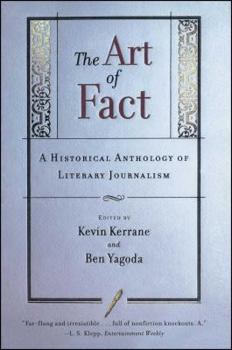The Art of Fact: A Historical Anthology of Literary Journalism
Select Format
Select Condition 
Book Overview
Learn how to be the best journalist you can be with what "could be the world's most readable textbook" (Time Out New York). The Art of Fact is a historical treasury tracing literary journalism back to such pioneers as Defoe, Dickens, and Orwell, and to crime writers, investigative social reporters, and war correspondents who stretched the limits of style and even propriety to communicate powerful truth. Here an extraordinary range of styles--the elegance of Gay Talese, the militance of Marvel Cooke, the station-house cynicism of David Simon, the manic intelligence of Richard Ben Cramer--illuminates an extraordinary range of subjects. From large public events (Jimmy Breslin on the funeral of JFK) to small private moments (Gary Smith on the struggles of a Native American basketball player), these readings--sad, funny, and most of all provocative--offer the double pleasure of true stories artfully told.
Format:Paperback
Language:English
ISBN:0684846306
ISBN13:9780684846309
Release Date:August 1998
Publisher:Scribner Book Company
Length:560 Pages
Weight:1.39 lbs.
Dimensions:1.4" x 6.2" x 9.4"
Customer Reviews
3 ratings
Extraordinarily Fine
Published by Thriftbooks.com User , 16 years ago
While familiar with most of the writers in this book (Defoe, Boswell, Dickens, Whitman, Crane, Richard Harding Davis, London, Hersey, Lillian Ross, Talese, Capote, Tom Wolfe, Kidder, Orwell, Liebling, Mailer, Hunter Thompson, Hemingway, Agee, Joseph Mitchell, Rebecca West, Steinbeck, Breslin, Didion, and McPhee), I generally was not familiar with the works included. Additionally, there are numerous other writers I was not familiar with, so most of the reading experience was new to me. The variety of the works chosen is as impressive as their general excellence. In sum, the editors (both of whom teach English and journalism at the University of Delaware) have succeeded in producing a volume that is a delight to read. The only book that I'm aware of that is in the same league is Literary Journalism. Highly recommended.
This is Writing, not typing; and it's worth reading
Published by Thriftbooks.com User , 18 years ago
Perhaps the reduction in reading of 'literary novels' is due to the general decline in other forms of writing: evidence of this possibility can be found by comparing the original styles of prose collected in this anthology with the general journalistic style today that is either turgid, 'stylishly hip (meaning writing TO the audience, not FOR the audience,' or just plain banal. Every newspaper on-line or off now has a 'new journalist' feature or features, but there are two problems with most of the writers who work on them: they are mediocre writers because they have not learned from people who write well nor have they taken the time to become keen observers of human behavior; To take just two examples from this book, Gary Smith writes about basketball and Native Americans in Montana and finds the soul of his subject while R. Ben Kramer takes a look at Bob Dole in the 1988 primaries and finds the hurt spirit beneath his mediated image. Such observation and expression requires a devotion to understanding one's subject, not a devotion to drawing attention to one's self. Literary journalists nowadays cater to the desires of their editors, which means too often, the desires of their publishers and in turn the desires of the corporation that owns the entity, and most likely the corporation doesn't know anything about writing or humanity, and couldn't care less. True 'literary journalism' is an art form, but like other skills it requires lots of apprenticeship, honing, and maturation. Right now such values are on hiatus owing to our need to quickly fill the 'information hole' of a vast array of media: the results being cloned authors coming off an assembly line.
The best survey of non-fiction and its development I've seen
Published by Thriftbooks.com User , 26 years ago
As a writer of non-fiction, I'm grateful to the editors of this book. It's the best and most complete survey of the development of non-fiction writing I've found, reaching back to Defoe for examples of techniques we've come to think of as recent developments non-fiction reporting, and moving through the "new journalism" writers to contemporary writers such as Ted Conover and Michael Winerip. The editors have written elegant prefaces not only to the book but to each of the dozens of writers included,giving biographical information, historical context, and information on the writing they've chosen to include (why they chose an early Hemingway column from the Toronto Star, for instance; the importance of Joseph Mitchell's profile on a bearded lady as opposed to his more well-known pieces). I would have liked to have seen something from Ian Frazier's Great Plains or Janet Malcolm's meditation on the art and impossibility of objective biography The Silent Woman, both of which push the craft of non-fiction writing into original territory. Nonetheless, this is a great book for students of non-fiction, non-fiction writers and especially for teachers of non-fiction. And as a collection of great writing, it's also great reading.





